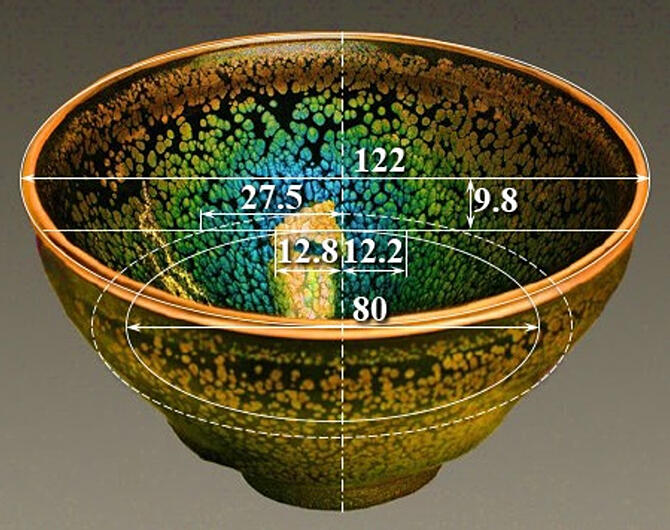A team led by Research Scientist Noboru Ebizuka of the Ultrahigh Precision Optics Technology Team at the RIKEN Center for Advanced Photonics and Senior Research Scientist (at the time of research) Takayuki Okamoto of the Advanced Device Laboratory at RIKEN Cluster for Pioneering Research have successfully explained the bluish-violet iridescent colors observed in the national treasure 'Yuteki Tenmoku Tea Bowl.' Using a two-dimensional (2D) diffraction grating structure, the researchers found that the bluish-violet iridescence of the tea bowl could be attributed to the reflection of its oil drops and glaze. This finding was deduced from electron microscopic images of ceramic shards obtained in the same period as the photographic data. This achievement is expected to lead to the development and understanding of optimal lighting techniques and manufacturing methods for viewing tea bowls. The results were published in the September 10, 2023 issue of Kogaku, a journal published by the Optical Society of Japan (OSJ).

Provided by RIKEN
While most tenmoku tea bowls are covered with a thick black glaze, Yuteki Tenmoku Tea Bowls are unique in that spots resembling oil drops can be observed on their shiny black glaze. The iron-glazed black tenmoku tea bowls fired at Jian Kilns in Fujian Province during the Song Dynasty in China are called 'Kensan.' Kensan accounts for four of the eight tea bowls that are considered a national treasure in Japan.
The research team began their study when photographer Shigeru Nishikawa noticed that the colors of the national treasure Yuteki Tenmoku Tea Bowl could be vividly captured when it is illuminated with an L. Ecolight. The team examined electron microscopic images of 2D wrinkles on the glaze surface obtained from a previous study as well as the iridescent colors caused by the light diffraction of these wrinkles.
The positions of the distorted light reflected from a surface light source and bluish-green iridescence on the inner surface of the Yuteki Tenmoku Tea Bowl were measured from photographs that had been processed using image-editing software to increase their saturation. When the diffracted light with a wavelength of 400 nanometers (nm) emitted from both ends of the surface light source was located near the ends of the light reflected from this source, the period of the wrinkles was 900 nm.
The researchers calculated the diffraction efficiency for a one-dimensional diffraction grating with a metallic iron reflective layer on its backside, wrinkles with a periodicity of 900 nm and a depth of 100 nm. They found that the efficiency at a wavelength of 400 nm (bluish violet) was approximately twice that at a wavelength of 700 nm (red) for light incident perpendicular to the surface.
The iridescence of the Yuteki Tenmoku Tea Bowl resulted from the diffraction of light produced by a 12.8-millimeter-wide light source from a 2D wrinkle pattern with a period of 900 nm and a depth of 100 nm. The light reflected from this source, which acts as zero-dimensional light (i.e., light that travels in the same direction regardless of wavelength or, in the case of transmission, transmitted light), is diffracted. Assuming that the intensity of the diffracted light at 400 nm is approximately 3.5 times that at 700 nm, the long-wavelength components gradually increase from the edge of the reflected light (at a wavelength of 400 nm). Due to this, the iridescence of the tea bowl changes from bluish violet to light blue or bluish green. At positions in which the entire spectrum of visible light (from 400 to 700 nm) overlaps, the iridescence is likely to appear light blue or bluish green.
Beyond this wavelength, the light gradually loses its short-wavelength components from 400 nm, changing from light blue or bluish green to green, yellow, orange, and then red. In white-light-emitting diode (LED) surface light sources, blue LEDs, which serve as excitation light sources for fluorescent substances, show a strong peak at wavelengths of 450-460 nm. Thus, the iridescence at the position containing this wavelength is bluish.
The highly saturated photograph of the Yuteki Tenmoku Tea Bowl showed a change in iridescence from blue to light blue, and then green on both sides of the edge of the light reflected from the surface light source. The results obtained in this study are expected to provide clues for proposing optimal lighting for viewing and clarifying glaze formulations and firing methods.
Ebizuka stated, "I am involved in the development of diffraction gratings used in astronomical instruments, such as the 8.2-meter Subaru Telescope and the next-generation Thirty Meter Telescope (TMT), and lunar polar exploration projects. When I first saw the electron microscopic images of the glaze surfaces of the tea bowl, I was inspired to explain the iridescence of these surfaces as diffraction patterns caused by wrinkles. This idea served as the basis for this study. Initially, I attempted to obtain a simple explanation of the colors on the surface by assuming that the inside of the tea bowl was spherical or using the diffraction angles of monochromatic light. However, following discussions with my co-author Okamoto, and after being given valuable advice by the peer reviewers, I was able to represent colors and diffraction-light intensity that were closer to reality. This process provided me with an opportunity to study topics such as elliptical equations and color spaces, which I do not usually deal with in my work. Because of this, the study has been a refreshing experience."
This article has been translated by JST with permission from The Science News Ltd. (https://sci-news.co.jp/). Unauthorized reproduction of the article and photographs is prohibited.




